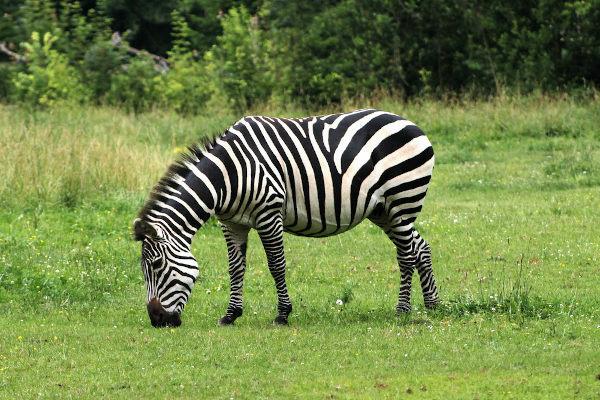herbivorous animals are those animals that have a diet based on the ingestion of vegetables and/or algae. This is the case, for example, of oxen and caterpillars, animals that feed on vegetable. To ensure good use of the food they eat, these animals present a series of adaptations. It is noteworthy that it is not only animals that present adaptations related to herbivory, but also plants, which, in this case, seek to avoid this eating habit.
Read too: Herbivory, an important ecological relationship
Examples of herbivorous animals

There is a wide variety of herbivorous animals on our planet, and it is possible to observe representatives both in the vertebrate group and in the invertebrate group. As examples of herbivorous animals, we can mention:
horse;
Bee;
butterfly and its larval stage (caterpillar);
Amazonian manatee;
Bunny;
ox;
elephant;
giraffe;
Toucan;
zebra;
sheep;
rhinoceros;
kangaroo;
deer;
koala.
Herbivorous animals and the food chain
Herbivorous animals feed on algae and/or plants, that is, on producing organisms. For this reason, in a chain or food web, herbivores will always occupy the position of primary consumers. Omnivorous and carnivorous animals, however, can occupy other trophic levels depending on the organism they are ingesting.
Read too: Wild Animals — What Are Their Characteristics?
Herbivorous, carnivorous and omnivorous animals
Animals can be classified, according to their eating habits, into three basic groups: herbivores, carnivores and omnivores.
Herbivores: are those that feed on plants and/or algae.
Carnivores: feed-if from other animals. O Lion it is an example.
Omnivores: those that have a mixed diet, feeding on both animals and plants and/or algae. The human being is an example of omnivorous animal.
Adaptations of animals to herbivorous food
Herbivorous animals have adaptations that guarantee the ingestion of algae and/or plants. The first important adaptation to be mentioned concerns the mouth. US insects, for example, we can observe a great diversity of mouthparts, which are adapted, for example, to chewing leaves, as in caterpillars, crickets and grasshoppers, or to sucking nectar from flowers, as seen in butterflies.
Adaptations in the mouth, however, are not exclusive to invertebrates. Atbirds, for example, feature beaks, that help in the herbivorous habit. We can easily verify these adaptations when we observe the hummingbird's beak, which is long and helps in the removal of nectar from the flowers.
You mammals they are also noteworthy in this regard, and it is important to mention the presence of teeth that ensure a more efficient crushing for this type of food. In herbivorous mammals, the dentition it is basically composed of premolars and molars, and the incisors and canines are generally modified in order to ensure that the animal is able to bite into the food.

The adaptations of herbivores to this type of food do not stop there. Generally speaking, herbivores have a longer digestive tract than carnivores. This is important as the digestion of vegetables is much more complex and time-consuming than animal foods.
It is worth noting that animals are unable to synthesize enzymes that break down cellulose (major component of plant cell walls). In this way, they establish mutualistic relationships (ecological relationship between individuals of different species in which both are benefited by the interaction), in order to ensure greater efficiency in the use of their food. In termites, it is observed the presence of protists acting in this role, ensuring the breakage of the cellulose in the wood. In vertebrates, the presence of bacteria that promote the digestion of cellulose.

A digestive system well adapted to herbivorous food is present in the so-called ruminants. In these animals, there is the presence of a stomach with four chambers (rumen, reticulum, omasum and abomasum) and a digestion process involving the passage of food twice through the mouth.
Right after chewing the food, it moves towards the rumen and to the reticulum, where mutualistic microorganisms act to break down the cellulose. The food returns to the mouth, where it is chewed again. The food is then swallowed and moves towards the omasum and abomasum. In the omasum, part of the water is absorbed and, in the abomasum, the food undergoes the action of digestive enzymes. Digestion then continues in the small intestine and large intestine, with the faeces being passed through the anus. To learn more, read:ruminant animals.
Plant adaptations against herbivory
Plants are directly affected by herbivory (ecological relationship in which an animal feeds on a plant or algae), which may have some organs destroyed, such as leaves and flowers, or even be completely ingested. To avoid this process, they have a series of adaptations that give them relative protection. In the presence of thorns and trichomes (structures found in the plant epidermis that resemble hairs), for example, they are ways to drive away herbivores. In addition, many plants have the ability to produce metabolites, which can, for example, make the vegetable unpalatable, that is, unpleasant to the palate. The production of these compounds is therefore a chemical defense.

